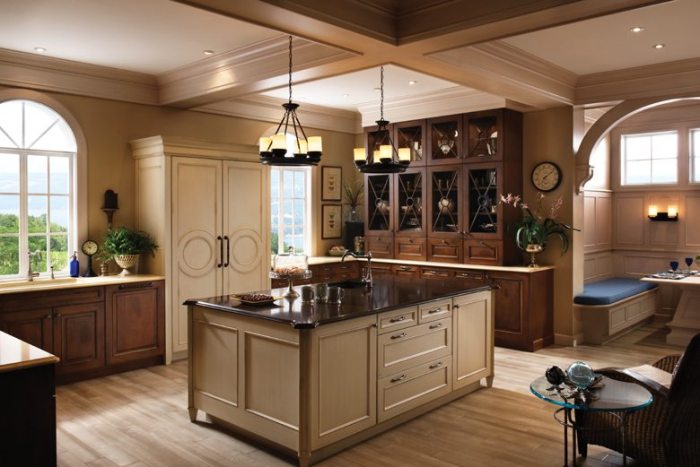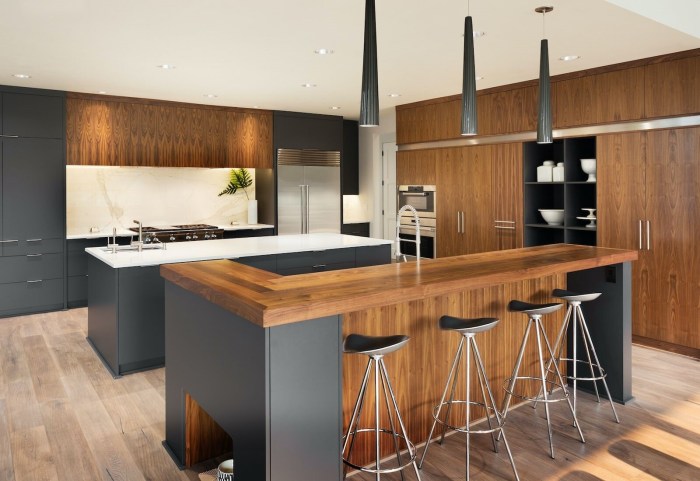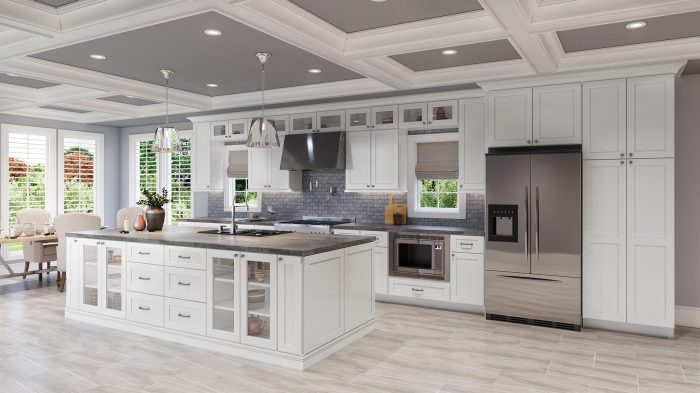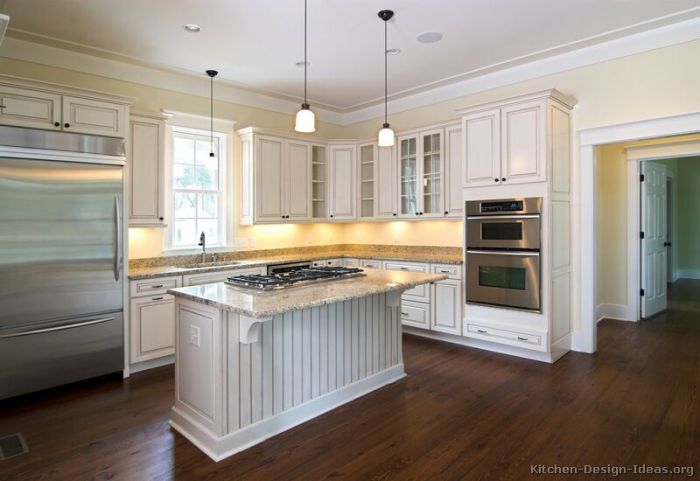The allure of a luxury American Classic kitchen lies in its masterful blend of timeless elegance and enduring practicality. This design aesthetic, deeply rooted in historical American styles, evokes a sense of warmth, sophistication, and enduring quality. From the carefully selected color palettes to the meticulously chosen materials, every element contributes to an atmosphere of refined comfort. This exploration delves into the defining characteristics of this style, examining its historical influences, comparing it to contemporary trends, and showcasing the key elements that contribute to its unique charm.
We will journey through the evolution of this iconic kitchen design, tracing its lineage from historical precedents to its modern interpretations. We’ll explore the rich tapestry of color palettes, the luxurious textures of premium materials, and the strategic placement of furniture and fixtures that contribute to both functionality and aesthetic appeal. This exploration will also uncover how contemporary technology and design innovations can be seamlessly integrated into this classic style, creating a space that is both timeless and technologically advanced.
Defining “Luxury American Classic Kitchen Decor”

Luxury American Classic kitchen decor represents a sophisticated evolution of traditional American design principles, blending timeless elegance with high-end materials and craftsmanship. It draws inspiration from various historical periods, resulting in a style that is both richly layered and effortlessly refined. This aesthetic prioritizes enduring quality and meticulous detail, creating a space that is both functional and visually stunning.
Core Characteristics of Luxury American Classic Kitchen Decor
This style is characterized by a careful balance between formality and warmth. It avoids ostentatious displays of wealth, instead focusing on subtle details and high-quality materials that speak to enduring value. Key features include custom cabinetry crafted from premium wood species like cherry or mahogany, often featuring intricate detailing such as raised panel doors or hand-carved accents. Countertops are typically made from materials like marble, granite, or quartzite, chosen for their durability and aesthetic appeal.
The color palette often leans towards neutral tones—creamy whites, soft beiges, and deep greens—accentuated by metallic finishes like brushed nickel or antique brass. The overall effect is one of understated elegance and timeless sophistication.
Historical Influences on Luxury American Classic Kitchen Design
The aesthetic is deeply rooted in American history, drawing inspiration from various periods. Elements of Colonial and Federal styles, with their emphasis on symmetry and craftsmanship, are evident in the use of paneled cabinetry and simple, elegant lines. The Arts & Crafts movement’s appreciation for handcrafted details and natural materials is reflected in the use of high-quality wood and the integration of natural stone.
Mid-century modern influences can be subtly incorporated through the use of streamlined cabinetry or the integration of stainless steel appliances, creating a harmonious blend of historical and contemporary elements. The overall style is a carefully curated synthesis of these historical influences, resulting in a unique and timeless aesthetic.
Comparison with Other Kitchen Design Styles
Unlike the rustic charm of farmhouse kitchens, which often feature exposed beams and distressed finishes, the luxury American classic style prioritizes a more polished and refined look. Farmhouse kitchens embrace a more casual and lived-in aesthetic, while the classic style maintains a sense of formality and order. Compared to modern kitchens, with their clean lines and minimalist approach, the luxury American classic style incorporates more intricate details and ornamentation.
Modern kitchens often favor sleek, handleless cabinetry and a monochrome palette, whereas the classic style embraces richer textures and a warmer color palette. While both styles prioritize functionality, the luxury American classic approach emphasizes timeless elegance and handcrafted quality over stark minimalism.
Iconic Design Elements of Luxury American Classic Kitchens
Several design elements consistently define this style. Custom-made cabinetry, often featuring intricate molding and raised panel doors, is a cornerstone. These cabinets are typically constructed from high-quality hardwoods and finished with meticulous attention to detail. Large, statement-making islands serve as both functional workspaces and focal points, often incorporating a butcher block countertop for a touch of rustic charm.
High-end appliances, seamlessly integrated into the design, enhance both functionality and aesthetic appeal. Pendant lighting, often featuring elegant glass shades or antique brass finishes, adds a touch of refined sophistication. Finally, the use of natural stone countertops, such as marble or granite, contributes to the overall feeling of luxury and timeless elegance. These elements, working in concert, create a kitchen that is both beautiful and functional, reflecting the enduring appeal of classic American design.
Color Palettes and Materials

The aesthetic foundation of a luxury American Classic kitchen rests on a careful interplay of color palettes and material choices. These elements work in concert to evoke a sense of timeless elegance, sophisticated warmth, and enduring quality. The selection process involves considering both the psychological impact of color and the physical properties of materials, ensuring a harmonious blend of form and function.
Scientifically, color psychology influences mood and perception, while material science dictates durability and maintenance.
Luxury American Classic Kitchen Color Palettes
Three distinct color palettes exemplify the versatility of this design style. Each palette offers a unique mood and atmosphere, catering to different preferences while remaining true to the core principles of American Classic design. These palettes are not arbitrary; they are informed by color theory and its established effects on human perception.
- Palette 1: Warm Neutral Elegance (#F5F0E1, #A0522D, #8B4513): This palette utilizes a creamy off-white (#F5F0E1) as a base, complemented by a rich, deep sienna (#A0522D) for accents and a darker, earthy brown (#8B4513) for grounding elements. This combination creates a feeling of warmth, sophistication, and understated luxury, reminiscent of traditional American homes. The contrast between the light and dark tones adds visual interest without being overwhelming.
- Palette 2: Cool Coastal Classic (#E0FFFF, #708090, #4682B4): This palette evokes a sense of airy coastal charm. A light, refreshing pale turquoise (#E0FFFF) forms the backdrop, balanced by a muted grey-blue (#708090) for cabinetry and a steely blue (#4682B4) for smaller accents. This cooler palette maintains a sense of classic elegance while introducing a touch of refreshing modernity. The subtle color variations create a calming and serene atmosphere.
- Palette 3: Sophisticated Monochromatic (#FAEBD7, #FFE4C4, #DEB887): This palette showcases the beauty of subtle variations within a single color family. A light peach (#FAEBD7) provides a soft and inviting base, layered with a slightly darker, warm beige (#FFE4C4) for cabinetry and a muted sandy brown (#DEB887) for flooring. This monochromatic approach offers a sense of unity and sophistication, highlighting the texture and quality of materials. The gentle tonal shifts create depth and visual interest.
Premium Materials in Luxury American Classic Kitchens
The choice of materials significantly impacts both the aesthetic and functional aspects of the kitchen. Luxury American Classic kitchens typically prioritize high-quality, durable materials that age gracefully, reflecting the enduring nature of the design style. The selection often balances natural materials with carefully chosen man-made alternatives, each offering distinct advantages.
Natural vs. Man-Made Materials
Natural materials like wood and stone contribute to the timeless appeal and organic warmth of the design, while man-made materials offer enhanced durability and consistency. For instance, while marble countertops offer unparalleled beauty and unique veining patterns, quartz countertops provide superior resistance to staining and scratching. The decision often hinges on balancing aesthetic preferences with practical considerations and maintenance requirements.
The inherent variability in natural materials, though often prized, also requires greater care and maintenance.
Material Specifications Table
| Material | Color Options | Cost Range | Durability |
|---|---|---|---|
| Cabinetry (Wood: Cherry, Walnut, Oak) | Various stains and finishes; natural wood tones | $$$ | High; requires regular maintenance |
| Countertops (Marble, Granite, Quartz) | Wide range of colors and patterns; natural veining (marble, granite) | $$$-$$$$ | Marble: moderate; Granite & Quartz: high |
| Flooring (Hardwood, Porcelain Tile) | Various wood stains; wide range of tile colors and styles | $$-$$$ | Hardwood: moderate; Porcelain Tile: high |
| Backsplash (Natural Stone, Ceramic Tile, Glass) | Variety of colors and textures; mosaics | $-$$$ | Variable; natural stone may require sealing |
Key Furniture and Fixtures

The heart of a luxury American Classic kitchen lies not only in its aesthetic but also in the carefully selected furniture and fixtures that seamlessly blend functionality with timeless elegance. These elements, from the substantial island to the meticulously chosen appliances, contribute to the overall atmosphere of refined comfort and understated opulence. The selection process prioritizes quality materials, expert craftsmanship, and a design philosophy that emphasizes both practicality and enduring style.The key furniture pieces form the structural and visual backbone of the space.
Their proportions, materials, and detailing are crucial in establishing the desired aesthetic.
Essential Furniture Pieces and Their Stylistic Features
A substantial kitchen island serves as the central hub, often featuring a butcher block countertop of solid maple or cherry, reflecting a preference for natural, durable materials. Its size allows for ample food preparation space and casual dining. The island’s legs might be turned or feature decorative molding, showcasing traditional woodworking techniques. Complementing the island, a generously sized dining table, typically made from solid wood like oak or walnut, provides a formal setting for meals.
The table’s design often incorporates classic elements such as turned legs, a pedestal base, or intricate joinery. Chairs, upholstered in high-quality leather or luxurious fabrics like linen or velvet, add a touch of refined comfort and complete the dining area. These chairs might feature classic silhouettes, such as Windsor chairs or ladder-back chairs, or boast more contemporary designs that still retain the overall classic aesthetic.
High-End Appliance Brands
The selection of appliances is paramount in a luxury American Classic kitchen. These appliances are not merely functional; they are integral to the overall design scheme, reflecting a commitment to both performance and aesthetics. Brands synonymous with this aesthetic include Sub-Zero and Wolf, known for their professional-grade performance and sleek, timeless designs. Miele, with its reputation for quality and longevity, also aligns perfectly.
La Cornue, with its bespoke range cookers, represents the pinnacle of luxury and customization. Lastly, the inclusion of a high-end wine refrigerator, perhaps from brands like EuroCave or VintageView, adds a touch of sophisticated storage and enhances the overall luxurious feel.
Lighting Choices and Ambiance
Lighting plays a pivotal role in shaping the ambiance of a luxury American Classic kitchen. Recessed lighting provides functional illumination, ensuring adequate brightness for food preparation and cleaning tasks. However, it’s the statement lighting fixtures that truly elevate the space. Large-scale pendant lights, perhaps crafted from hand-blown glass or antiqued brass, hung above the island or dining table, create focal points and cast a warm, inviting glow.
These lights are often designed with classic forms, reflecting the traditional aspects of the style. The use of dimmer switches allows for customized lighting levels, creating different moods throughout the day, from bright and airy to warm and intimate. Strategically placed sconces on the walls add subtle ambient lighting, further enhancing the sense of refined elegance. The interplay of these different lighting sources ensures a layered and visually captivating space, highlighting the details of the furniture and fixtures while creating a welcoming atmosphere.
Illustrative Examples

The following examples demonstrate the versatility and elegance achievable within the framework of luxury American Classic kitchen design. These illustrations showcase diverse layouts, material choices, and decorative elements, highlighting the potential for personalization while maintaining the core aesthetic principles of the style. The scientific approach to design involves understanding the interplay of form, function, and material properties to create a harmonious and efficient space.
Luxury American Classic Kitchen Layouts
Three distinct layouts exemplify the adaptability of this design style. First, a classic galley kitchen, optimized for efficiency, features parallel countertops with ample storage on both sides. This layout, prevalent in older American homes, benefits from a linear flow, ideal for smaller spaces. The second layout, an L-shaped kitchen, offers a more expansive feel, allowing for an island or peninsula to serve as a focal point and additional workspace.
This configuration is particularly suited for larger homes, providing both efficient workflow and ample counter space. Finally, a U-shaped kitchen provides maximum counter and cabinet space, ideal for larger families or avid cooks. The three sides of cabinetry create a sense of enclosure and intimacy, while strategically placed windows can prevent the space from feeling cramped. The choice of layout is determined by the available space and the homeowner’s needs.
Luxury American Classic Backsplash Designs
The backsplash plays a crucial role in establishing the aesthetic character of the kitchen. One example features a classic subway tile installation, employing a high-quality ceramic or porcelain tile in a crisp white or creamy off-white hue. This timeless choice provides a clean backdrop and enhances the sense of spaciousness. A second option utilizes a natural stone backsplash, such as marble or limestone, cut in large format tiles or slabs.
The veining and textural variations of natural stone introduce subtle elegance and a sense of luxury. The third backsplash design incorporates a hand-painted ceramic tile featuring a subtle repeating pattern, perhaps a delicate floral motif or geometric design, evoking a sense of handcrafted artistry. The use of color in this instance should remain muted and complement the overall palette.
Decorative Elements in Luxury American Classic Kitchens
The incorporation of carefully chosen decorative elements elevates the design from functional to luxurious. Crown molding, typically detailed and substantial, adds a sense of grandeur and sophistication. Cabinet hardware, such as antique brass or polished nickel knobs and pulls, contributes significantly to the overall aesthetic. Architectural details, such as exposed beams or decorative corbels, further enhance the sense of history and craftsmanship.
These elements, often inspired by traditional American styles, should be selected to create a cohesive and harmonious atmosphere. For example, the use of Shaker-style cabinetry, known for its clean lines and simple elegance, is a hallmark of this style.
Luxury American Classic Kitchen Island Design
A substantial kitchen island serves as a central feature in many luxury American Classic kitchens. Consider an island measuring approximately 8 feet long by 4 feet wide, constructed from a durable and aesthetically pleasing material such as butcher block or a high-quality quartz countertop. The island’s base could be crafted from solid wood, potentially painted in a contrasting yet complementary color to the cabinetry.
The island should incorporate ample storage, possibly including drawers and cabinets, to enhance functionality. A built-in sink or a cooktop could be integrated into the island’s design, further enhancing its practicality and making it the heart of the kitchen. The island’s dimensions should be carefully planned to ensure sufficient workspace and easy navigation within the kitchen. The inclusion of seating, such as bar stools, adds a social dimension to the space.
Modern Interpretations
The enduring appeal of luxury American Classic kitchen design lies in its timeless elegance. However, the modern homeowner desires both beauty and functionality, demanding a seamless integration of contemporary elements. This necessitates a careful balancing act: preserving the soul of the classic style while embracing the technological advancements and streamlined aesthetics of the 21st century. The key is not to replace the classic elements but to refine and reinterpret them, creating a space that feels both historically resonant and refreshingly modern.Contemporary interpretations of luxury American Classic kitchens often involve a subtle shift in emphasis.
While traditional designs might prioritize ornate detailing and heavily carved woodwork, modern interpretations favor cleaner lines, simpler profiles, and a more minimalist approach to ornamentation. This doesn’t mean sacrificing richness; instead, it refines it, allowing the quality of materials and craftsmanship to speak for themselves. The effect is a kitchen that feels both luxurious and effortlessly chic.
Technological Integration in Luxury American Classic Kitchens
Smart technology can be seamlessly integrated without disrupting the classic aesthetic. Concealed appliances, such as induction cooktops with integrated ventilation systems, maintain a clean countertop profile while offering advanced functionality. Custom cabinetry can incorporate charging stations and hidden compartments for smart devices, keeping technology discreet yet readily accessible. Furthermore, smart lighting systems, controlled via voice activation or a dedicated app, allow for adjustable ambiance, perfectly complementing the overall mood of the space.
Imagine, for example, a kitchen where the under-cabinet lighting subtly shifts from a warm, inviting glow during dinner to a crisp, bright white for meal preparation, all without compromising the elegant design. This integration of technology elevates the user experience without detracting from the classic elegance.
Comparison of Traditional and Modern Interpretations
Traditional luxury American Classic kitchens often feature heavy, dark wood cabinetry, elaborate moldings, and prominent hardware. Color palettes are typically rich and warm, featuring deep blues, greens, and reds, often accented with gold or brass. Modern interpretations, however, may utilize lighter woods, such as bleached oak or maple, with sleek, minimalist cabinetry and integrated handles. Color palettes lean toward neutral tones—creamy whites, soft grays, and muted pastels—allowing the natural beauty of materials to take center stage.
While both styles emphasize high-quality materials, the modern approach prioritizes clean lines and a less ornate aesthetic. The contrast lies in the level of ornamentation and the overall feeling: traditional evokes a sense of grandeur and history, while modern projects a sense of understated sophistication and calm.
Innovative Design Features Blending Classic and Modern Elements
The successful marriage of classic and modern styles requires thoughtful consideration. Here are five innovative design features that achieve this balance:
- Statement Backsplash with Geometric Pattern: A classic subway tile backsplash, but with a modern twist, using a geometric pattern or a contrasting grout color to create visual interest. This adds a contemporary element without sacrificing the timeless appeal of subway tile.
- Sleek, Minimalist Cabinetry with Antique Hardware: Clean-lined cabinetry in a light-colored wood or lacquer, paired with antique brass or bronze hardware. This juxtaposition of modern simplicity and historical detail creates a captivating contrast.
- Open Shelving with Carefully Curated Displays: Incorporating open shelving alongside closed cabinetry. The open shelving provides a modern, airy feel, while the careful curation of displayed items—perhaps antique ceramics or vintage cookbooks—maintains a classic aesthetic.
- Integrated Appliances with Custom Paneling: High-end appliances seamlessly integrated into the cabinetry using custom paneling to match the surrounding woodwork. This maintains a clean, uncluttered look, consistent with both styles.
- Island with Waterfall Edge Countertops: A large kitchen island with a waterfall edge countertop made from a luxurious material such as marble or quartz. The waterfall edge, a contemporary design element, adds a touch of modern sophistication while the luxurious material maintains the classic feel of high-quality craftsmanship.
Final Summary
Ultimately, the luxury American Classic kitchen transcends mere aesthetics; it represents a lifestyle. It’s a space where history meets modernity, where functionality and beauty coexist in perfect harmony. By understanding the core principles of this design style – its historical roots, material choices, and the careful orchestration of space and light – one can create a kitchen that is not only visually stunning but also a true reflection of personal style and refined taste.
The careful consideration of details, from the subtle nuances of color to the precise placement of lighting fixtures, culminates in a kitchen that is both a sanctuary and a testament to enduring design principles.
FAQ Section
What is the average cost of a luxury American Classic kitchen renovation?
The cost varies significantly depending on the size of the kitchen, the materials used, and the level of customization. Expect to invest a substantial amount, potentially ranging from $50,000 to well over $200,000 for a truly luxurious renovation.
How do I maintain the integrity of the classic style while incorporating modern appliances?
Choose appliances with a timeless design aesthetic – stainless steel finishes often work well, or consider panel-ready appliances that can be integrated seamlessly into cabinetry. Prioritize functionality without sacrificing the overall visual harmony.
What are some common mistakes to avoid when designing a luxury American Classic kitchen?
Overdoing ornamentation, neglecting proper lighting, and choosing materials that clash with the overall aesthetic are common pitfalls. Careful planning and attention to detail are paramount.
Can I achieve this style on a smaller budget?
Yes, by making strategic choices in materials (e.g., opting for less expensive but high-quality alternatives) and focusing on key elements, you can create a more budget-friendly version of this style. Prioritize quality over quantity.
Where can I find inspiration for luxury American Classic kitchen designs?
Architectural digest, design magazines, and online design platforms are great resources. Visiting showrooms and working with a kitchen designer can also provide valuable inspiration and guidance.